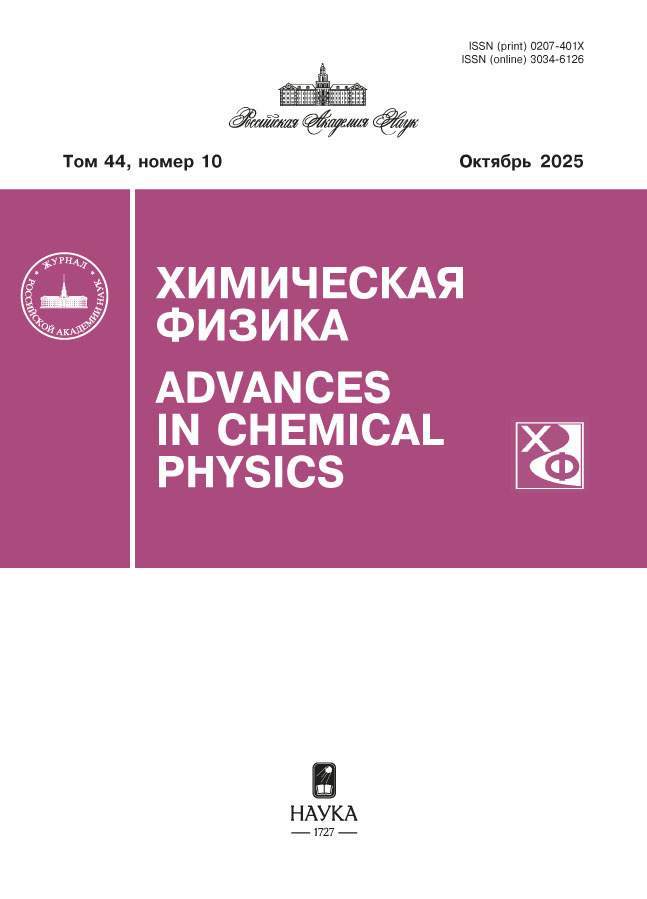The glow of Mg and Ca atoms when they interact with H atoms
- Authors: Petinov V.I.1, Timin V.M.1, Bozhenko K.V.1, Utenyshev A.N.1
-
Affiliations:
- Federal Research Center of Chemical Physics and Medicinal Chemistry of the Russian Academy of Sciences
- Issue: Vol 43, No 4 (2024)
- Pages: 3-7
- Section: Элементарные физико-химические процессы
- URL: https://cardiosomatics.orscience.ru/0207-401X/article/view/674955
- DOI: https://doi.org/10.31857/S0207401X24040015
- EDN: https://elibrary.ru/VFLBSM
- ID: 674955
Cite item
Abstract
During the evaporation of magnesium and calcium in partially dissociated H2, a glow with λ = 4571.15 Å and λ = 6572.78 Å was detected, corresponding to the transitions 3P10 → 1S0 in excited Mg* and Ca* atoms. It is assumed that this phenomenon is associated with the chemiluminescence of these atoms when they interact with H atoms.
Full Text
About the authors
V. I. Petinov
Federal Research Center of Chemical Physics and Medicinal Chemistry of the Russian Academy of Sciences
Email: bogenko@icp.ac.ru
Russian Federation, Chernogolovka
V. M. Timin
Federal Research Center of Chemical Physics and Medicinal Chemistry of the Russian Academy of Sciences
Email: bogenko@icp.ac.ru
Russian Federation, Chernogolovka
K. V. Bozhenko
Federal Research Center of Chemical Physics and Medicinal Chemistry of the Russian Academy of Sciences
Author for correspondence.
Email: bogenko@icp.ac.ru
Russian Federation, Chernogolovka
A. N. Utenyshev
Federal Research Center of Chemical Physics and Medicinal Chemistry of the Russian Academy of Sciences
Email: bogenko@icp.ac.ru
Russian Federation, Chernogolovka
References
- M. Ya. Gen, A.V. Miller, Russ. J. Poverxhnost 2, 150 (1983).
- V. I . Petinov, Russ. J. Phys. Chem. A 90 (7) 1413 (2016). https://doi.org/
- E. D. Gordon, A. N. Ponomarev, V. L. Talroze, Russ. J. Kinetika I Kataliz 7, 577 (1966).
- G. Fletcher, I. Branan, Proc. Roy. Sos. A250, 389 (1959).
- Elyashevich. Atomnaya I Molekulyarnaya spektroskopiya. М.: Aditorial, URSS (2001).
- Gaussian 09, Revision A.02, M. J. Frisch, G. W. Trucks, H. B. Schlegel, G. E. Scuseria, M. A. Robb, J. R. Cheeseman, G. Scalmani, V. Barone, G. A. Petersson, H. Nakatsuji, X. Li, M. Caricato, A. Marenich, J. Bloino, B. G. Janesko, R. Gomperts, B. Mennucci, H. P. Hratchian, J. V. Ortiz, A. F. Izmaylov, J.L. Sonnenberg, D. Williams-Young, F. Ding, F. Lipparini, F. Egidi, J. Goings, B. Peng, A. Petrone, T. Henderson, D. Ranasinghe, V. G. Zakrzewski, J. Gao, N. Rega, G. Zheng, W. Liang, M. Hada, M. Ehara, K. Toyota, R. Fukuda, J. Hasegawa, M. Ishida, T. Nakajima, Y. Honda, O. Kitao, H. Nakai, T. Vreven, K. Throssell, J. A. Montgomery, Jr., J. E. Peralta, F. Ogliaro, M. Bearpark, J. J. Heyd, E. Brothers, K. N. Kudin, V. N. Staroverov, T. Keith, R. Kobayashi, J. Normand, K. Raghavachari, A. Rendell, J. C. Burant, S. S. Iyengar, J. Tomasi, M. Cossi, J. M. Millam, M. Klene, C. Adamo, R. Cammi, J. W. Ochterski, R. L. Martin, K. Morokuma, O. Farkas, J. B. Foresman, and D. J. Fox, Gaussian, Inc.,Wallingford CT, 2016.
- E. V. R. de Castro and F. E. Jorge, J. Chem. Phys. 108, 5225 (1998). https://doi.org/10.1063/1.478392
- F. Weigend and R. Ahlrichs, Phys. Chem. Chem. Phys. 7, 3297 (2005). https://doi.org/10.1039/b508541a
Supplementary files













